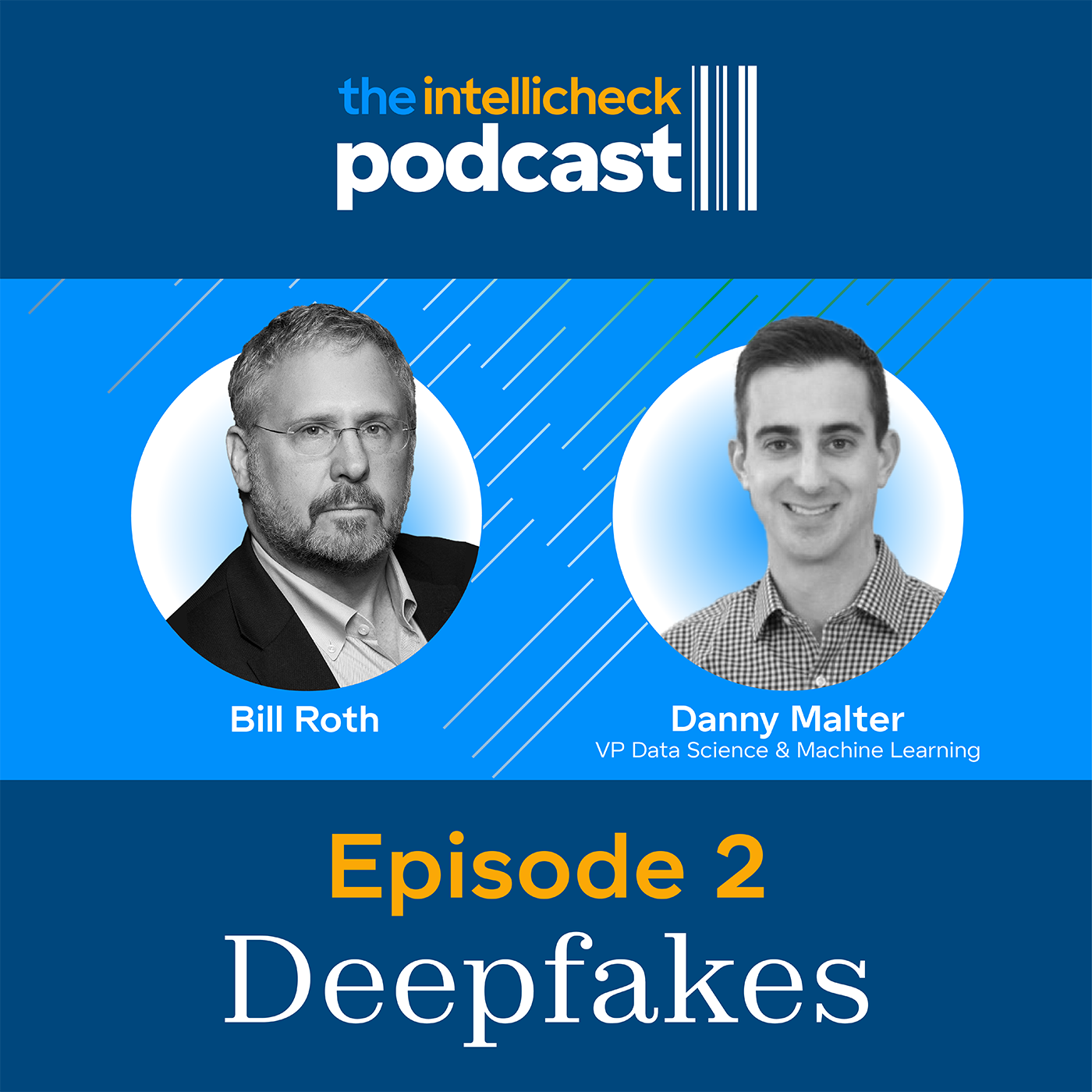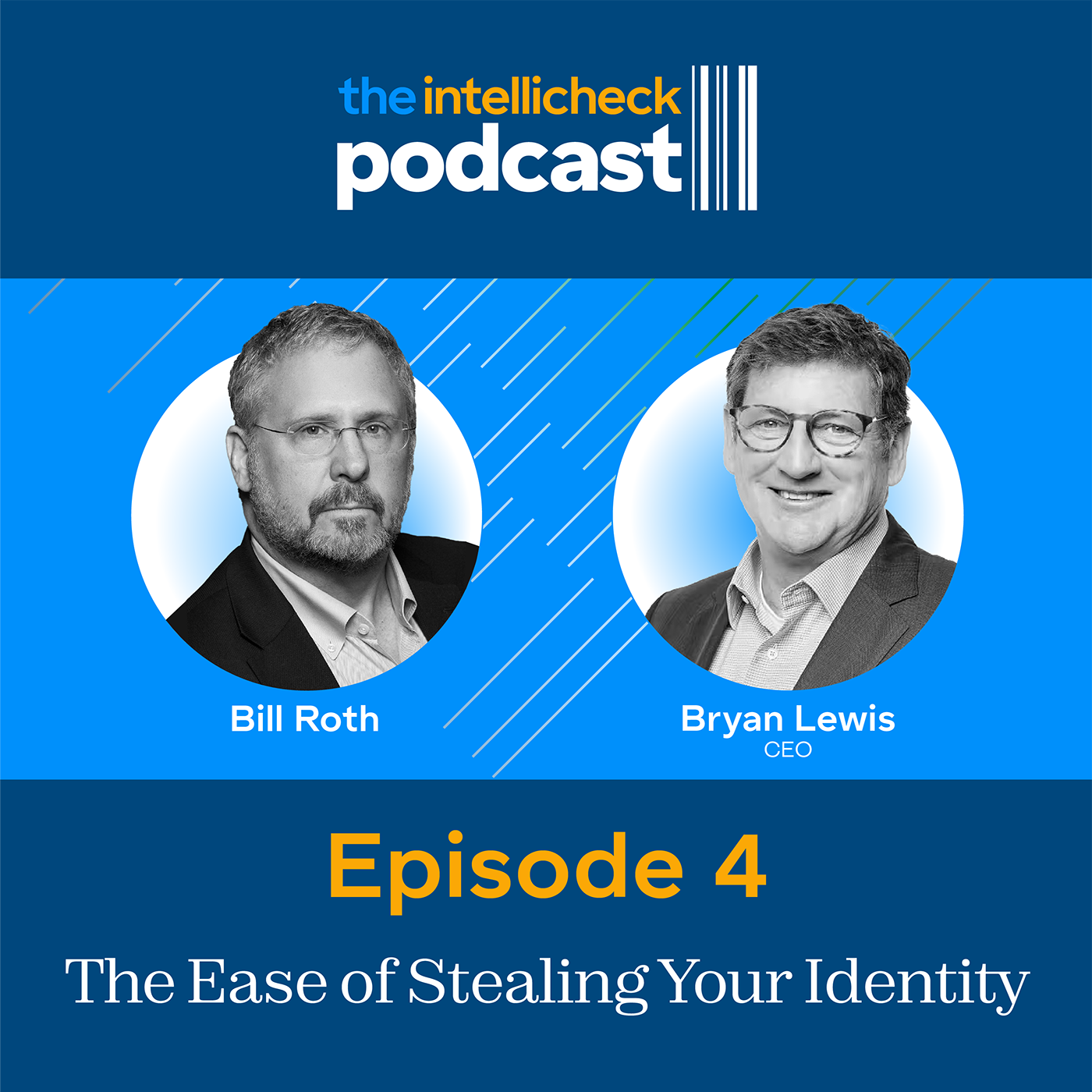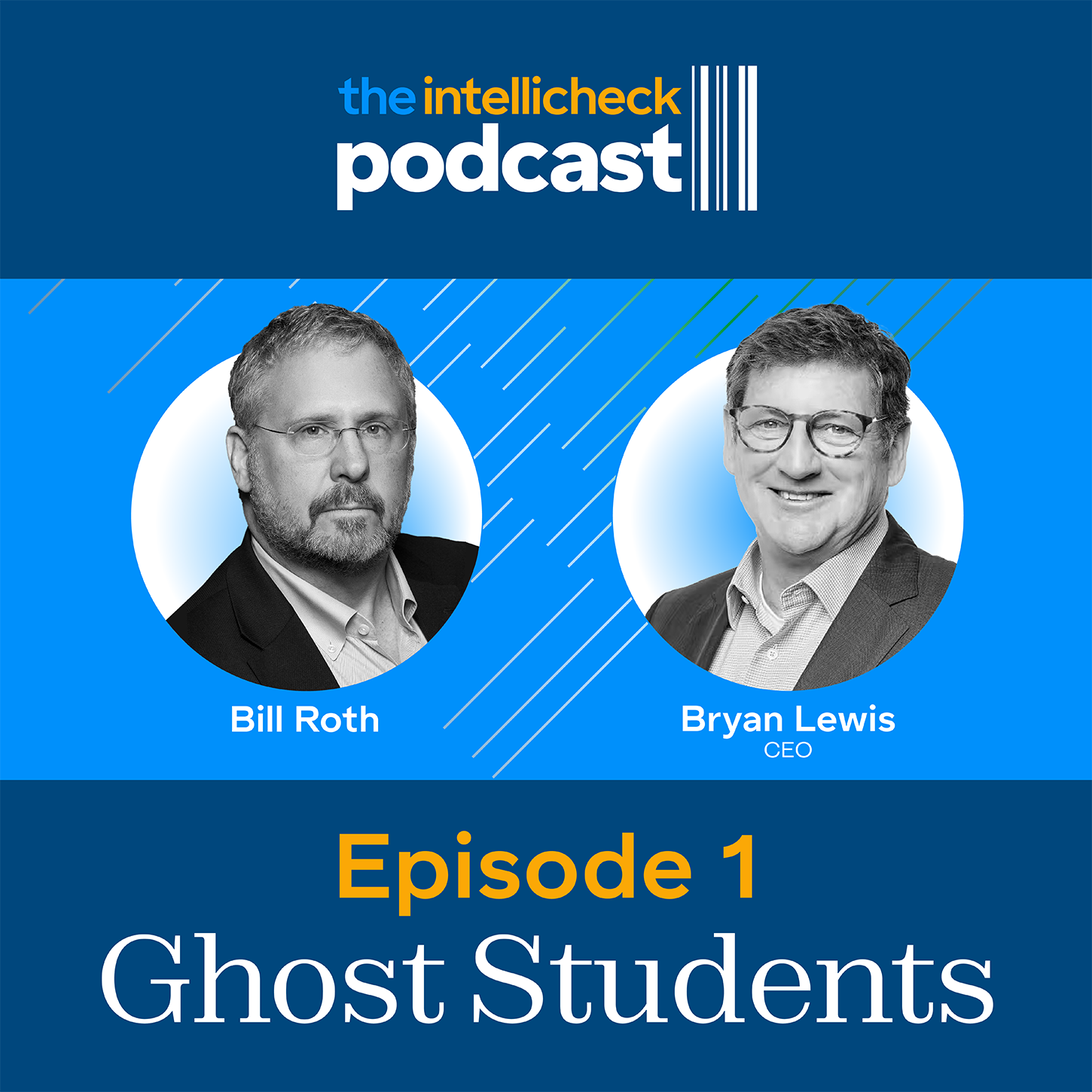Episode Transcript
Bill Roth: Hello and welcome Everybody to the second episode of the Intellicheck podcast. I'm your host, Bill Roth. This is the show where we delve into the news and issues around identity verification, identity fraud, and the tools needed to combat it.
This week, the topic is deep fakes.
How easy they are to create and how to stop them. And with us this week is an expert on the topic, Danny Malter, who is VP of Data Science and Machine Learning and Intellicheck. Welcome, Danny.
Danny Malter: Thanks. Nice to meet you, Bill.
Bill Roth: Nice to meet you, too. So we're on the same page. How would you define a deep fake?
Danny Malter: Yeah, so typically a deep fake is going to be defined as a synthetic media, typically AI-generated of a video or audio clip or it could also be an image. So in the world of identity, typically we would refer to a deep fake in the sense of an actual face being created of somebody else. Or it also could be related to an actual fake identity card. So people can with a human version of a deep fake or an actual identity card of a deep fake. Just at a high level here. Deepfakes are generally created with advanced AI. Really fancy word for neural networks, machine learning. The technology has been around for many years now. Only until recently though. They're starting to become very, very good.
Bill Roth: But if I want to deep fake my brother, what tools would I use?
How easy is it to do? Do I need, do I need to spend $1,000 with Amazon Web Services this month or, you know, what tools do you use for this?
Danny Malter: It's scary how many tools are out there. Just before this call, I was on the Apple App Store and there's a whole list of apps you can get for free. You can purchase.
You can use open source models that are already trained. So an open source model would mean somebody else has already created a deepfake model that I can now download and use for free. There's different scales to how well these deepfakes might work. If somebody's making a very sophisticated deep fake, they might not want to use a free version available on the App Store. But there's tools out there, they're relatively easy to use all the way up to. It requires some sophisticated programming to use.
When you actually get down to the programming level, you're not just using an app available on an app Store. You could get very detailed in these deepfakes too. I could add a smile. I want more of a smile because I'm deepfaking you and your smile. I could add a frown. I could make my eyes maybe tilted a little bit differently. I could add words of the hair. So you could really get down to very detailed personalization with these deep fakes.
Bill Roth: Oh, interesting. So you recently wrote an article about deepfaking your boss. Really risky career move, but I applaud you nonetheless.
And we will have a reference to that article in the show notes. But tell us about what you did.
Danny Malter: Yeah, so Jonathan, My boss, our CTO at Intellicheck, we have a good relationship, and I thought one day, it would be fun to deepfake Jonathan and maybe even scare him a little bit. So I had no background, really in creating deepfakes. Of course we have deepfake technology that we use at Intellicheck and tools and we'll talk about some of this. But I can't profess that I'm an expert in creating deep fakes. I did a little bit of coding programming in my own. This was all in Python programming. I had used available models that were freely available out there on the web. So in that sense, it did take a little bit of knowledge, a little bit of programming skills to do what I had done. But I'll tell you, it took less than a day to do it, probably a couple of hours if you really know what you're doing. And I personally think it was a pretty good deep fake. Now, of course, people who know me very well thought it was maybe just an older version of myself if you know Jonathan, it actually does look like Jonathan a little bit. I even tested this deep fake against known expert tools in the marketplace. And this deep fake that I created in just a few hours was able to get through some deepfake detections that probably are readily available.
Many companies might use some of these technologies.
Bill Roth: So Intellicheck makes its money on doing identity verification, validation.
How does Intellicheck technology sort of deal with deepfakes and solve the problems that deepfakes present?
Danny Malter: Yeah, so the big thing at Intellicheck, we're a multi-tiered identity platform. We start with the barcode, then we move up to different levels of identity checking. We check the front of the ID versus the back of the ID.
We have document liveness testing in place, where we test things like is this behind a screen, is this a piece of paper? And then face matching. So talking on each one of those, if somebody were to create a deep fake of, let's say, an identity card, that's probably pretty easy to do. But okay, that's fine. You still have to create a barcode with legitimate data in that barcode that's going to pass the Intellicheck system. Probably unlikely for somebody to do that.
The next step, document liveness. Most deepfakes are going to be created on the web. And when I hold up my phone to take a picture of my computer screen, we have technology in place that could detect it's a computer screen. All right, that deepfake is going to fail our system.
And then finally the face matching and face liveness. Now this is the one where people could probably create the best type of deepfake. I could deepfake you and fool a deepfake algorithm. But in that sense I still have to create a fake identity also with your information and create a barcode that passes Intellicheck system. So all of these steps need to be in place.
Bill Roth: Got it.
Danny Malter: All that has to be in place to get through us with a deep fake.
Bill Roth: That's interesting. So it's not just the barcode. When you do a deep fake, it's making sure that it not only the face matches, but that the underlying data matches as well. So it's sort of a multifactorial kind of process for doing identity checking.
Danny Malter: Absolutely. For any type of identity verification, fewer amount of checks you do, it's going to be easier for people to get through those systems. The more checks that you do, it's going to add more friction, possibly for the company, but it's going to make for a much more sophisticated identity platform.
Bill Roth: Excellent.
So what do you recommend?
So this is obviously terrifying.
I remember kind of when I first read the headline of your piece. But what are things that people can do to avoid being deepfake besides being a hermit and living in a cave?
Danny Malter: Yeah. So for one, from an identity company like ours, when we do things like face liveness checks or face matching checks, adding in randomness into our verification system. So maybe one person is asked to move their head in a circle. That's what we call active liveness versus passive liveness. A passive liveness test just takes a picture of myself and says yes or no. This is a, this is a live person. If I listen to that, I'm making it more difficult for the person behind that deep fake. So maybe I ask you to smile, but then else gets asked to blink, somebody else has to turn your head.
You've made it much more difficult now for that fraudster. The other thing from a user perspective. So I'm talking you and me is being cautious about the companies you're working with. You should be interested that your bank or your financial institution or your auto dealership is taking seriously the fact that they're doing identity verification.
If they're making it easy to use, you know, the limited checks and their identity verification, that means it's easier for a fraudster to use their system to make a deep fake of you or use your information even though they're a fraudster. So it's important. You should want your bank to have a very sophisticated identity system. And then lastly, the one thing that comes to my mind is be careful who you're interacting with if you're not sure who they are on the Internet. So one example that comes to my mind, I was with somebody recently and they got our text message from a random number, and we've all gotten that text message from a random number. In all likelihood, it's probably was just a mistake from somebody, but it could be a fraudster that's trying to maybe get your typing behavior or your types of words that you use. And the more you interact with that behavior, there's AI technology. I could learn how you speak, Bill. I could learn the words that you use. I can take.
And now I could easily become you. So if you're really not sure who you're speaking with, better to just ignore that person. I know it sometimes seems rude, but better be safe than sorry.
Bill Roth: Yeah, those are all, all great advice.
Well, folks, that's all we have time for today. My guest on the Intellicheck podcast has been the estimable Danny Malter, who's the VP of Data Science and Machine Learning at Intellicheck, and we've been discussing the issue of deepfakes.
Be sure to check in the show notes in the description. We'll have a list of the data and articles we've mentioned here, especially a link to Danny's podcast or Danny's blog on how he fairly riskily deepfaked his boss, seems to be okay. He still seems to be employed.
Danny Malter: Still working here for now.
Bill Roth: That's right.
All right, folks, thanks very much for listening to the Intellicheck podcast and see you next time. Until then, stay safe out there.



